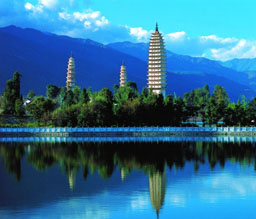 The ancient city of Dali is in southwestern China's Yunnan Province. It borders Lake Erhai in the east and Mount Cangshan in the west. Early in the second century B.C., Dali was established as a county and served as a bridge linking China with southeastern Asia in economy, trade, and cultural exchanges, and it is thus known by sociologists as "an ancient city at the intersection of Asian cultures." Dali saw great prosperity in the 700 years from the 7th through the 13th centuries.
The ancient city of Dali is in southwestern China's Yunnan Province. It borders Lake Erhai in the east and Mount Cangshan in the west. Early in the second century B.C., Dali was established as a county and served as a bridge linking China with southeastern Asia in economy, trade, and cultural exchanges, and it is thus known by sociologists as "an ancient city at the intersection of Asian cultures." Dali saw great prosperity in the 700 years from the 7th through the 13th centuries.
Different from China's other ancient cities such as those in the lower reaches of the Changjiang (Yangtze) River, which are delicately beautiful, and those on the central plains, which feature roughness and great momentum, Dali distinguishes itself with a mix of grace and rigidity. As spring comes, the snow on Mount Cangshan begins to melt and the water makes its way slowly along the flagstone-paved roads. All the flowers are in bloom, giving the city landscapes as beautiful as those in the lower reaches of the Changjiang. And in winter, snow carpets the ground and the withered grass shivers in the nippy wind, a scene typical of the central plains.
But the greatest charm of this ancient city lies in its history, culture, customs, and architecture, and this is the magnificence that attracts the many visitors who come every year.
What first impresses the visitors is the sight of flowers everywhere. There are flowers in every courtyard, and it is common to see elderly persons selling flowers on the streets. These peddlers take their work as a pastime and pay less attention to business than to decorating the streets with their flowers. The local people's leisurely way of life has changed the minds of many foreign tourists who originally intended to travel around the world. The foreigners stayed on in Dali and followed suit-growing flowers, reading, and collecting works of marble.
Pagodas from Ancient Times
Dali has many ancient pagodas, the most famous of which are the pagoda at the Hongsheng Temple, the White Pagoda at Yanghe, the Lingbao Pagoda, and the three Chongsheng Pagodas near the Chongsheng Temple.
The Chongsheng Pagodas are laid out in a triangle at the foot of Mount Cangshan. The construction of the pagodas began in the Tang Dynasty (618-907) and was completed in the Song Dynasty (960-1279). The principal pagoda is 69.13 meters high and each of the other two is 43 meters high, all having the same appearance. The pagodas have become landmarks in Dali City.
The Three-Course Tea Ceremony
Dali is mainly inhabited by the Bai people, and they have a custom of entertaining guests on festive occasions with a three-course tea ceremony. Eight or ten persons sit around a charcoal fire over which water is boiling in a copper kettle hung from the ceiling. Bai girls wearing white blouses and embroidered aprons over their skirts, serve the guests.
The girls first put tea leaves into a clay teapot already heating on a low fire and then pour boiling water over them. The tea tastes bitter, so the first course is known as the bitter tea. The tea for the second course tastes sweet because of an addition of brown sugar, sesame, and ground walnuts, hence its name, the sweet tea. And the third course is known as the flavored tea because the tea is flavored with honey and seasonings.
The Houses of the Bai
The Bai people in Dali all live in housing compounds similar to those in Beijing. Previously, a compound included a principal house, side houses, and a screen wall facing the gate and blocking the view from outside-all arranged in varied layouts. Today, two-story houses have replaced the old structures and can be found in every compound.
The Bai houses feature engravings on the gate tower, the doors, the windows, and the screen wall as well as color paintings on the main wall. The gate tower, the most beautiful part of the compound, features clay sculptures, woodcarvings, a marble screen, stone inscriptions, and color paintings along with overhanging eaves, painted pillars, and overlapping brackets.
The doors and windows of the wood structures are usually carved in relief with patterns of cranes, pines, peacocks, and magnolias-all traditional symbols for good fortune. The doors and windows are painted a glossy bright red, adding an antique, elegant flavor.
Screen walls are popular among the Bai and are found in every courtyard and at the entrance of villages. The walls are built of clay, tiles, bricks, and stones and engraved with auspicious characters. In back of the screen walls are large terraces with flowers all year round.
The March Street Festival
For the Bai people, the best time of the year is March, when Mount Cangshan, Lake Erhai, and the blooming camellias present breathtaking views. Thus the Bai people choose March for their most important annual event-the March Street Festival, celebrated at the foot of Mount Cangshan from the 15th to the 20th of the third lunar month.
The festival is a grand commodity fair and also features folk-art performances including songs, dances, and operas as well as horse racing, dragon-boat racing and other games. For the young people, the March Street Festival is a time for courting and singing on the banks of Butterfly-Spring Lake.
(China Pictorial March 20, 2003)
|

